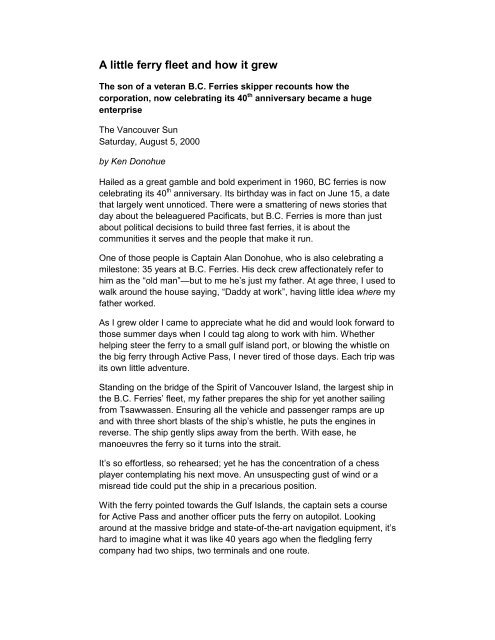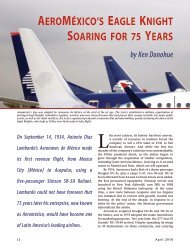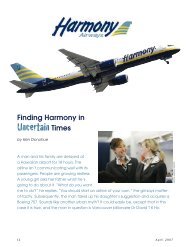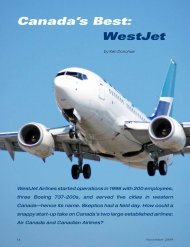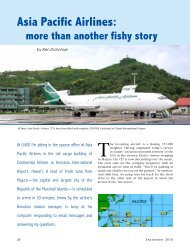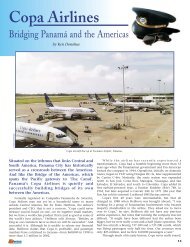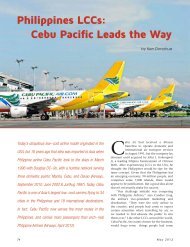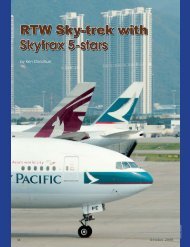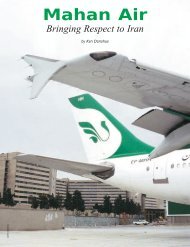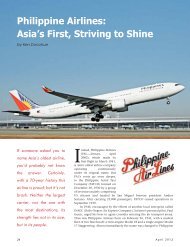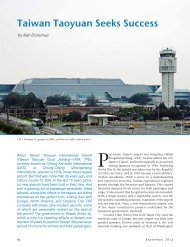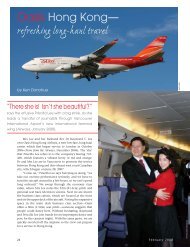A little ferry fleet and how it grew - Ken Donohue
A little ferry fleet and how it grew - Ken Donohue
A little ferry fleet and how it grew - Ken Donohue
Create successful ePaper yourself
Turn your PDF publications into a flip-book with our unique Google optimized e-Paper software.
A <strong>l<strong>it</strong>tle</strong> <strong>ferry</strong> <strong>fleet</strong> <strong>and</strong> <strong>how</strong> <strong>it</strong> <strong>grew</strong><br />
The son of a veteran B.C. Ferries skipper recounts <strong>how</strong> the<br />
corporation, now celebrating <strong>it</strong>s 40 th anniversary became a huge<br />
enterprise<br />
The Vancouver Sun<br />
Saturday, August 5, 2000<br />
by <strong>Ken</strong> <strong>Donohue</strong><br />
Hailed as a great gamble <strong>and</strong> bold experiment in 1960, BC ferries is now<br />
celebrating <strong>it</strong>s 40 th anniversary. Its birthday was in fact on June 15, a date<br />
that largely went unnoticed. There were a smattering of news stories that<br />
day about the beleaguered Pacificats, but B.C. Ferries is more than just<br />
about pol<strong>it</strong>ical decisions to build three fast ferries, <strong>it</strong> is about the<br />
commun<strong>it</strong>ies <strong>it</strong> serves <strong>and</strong> the people that make <strong>it</strong> run.<br />
One of those people is Captain Alan <strong>Donohue</strong>, who is also celebrating a<br />
milestone: 35 years at B.C. Ferries. His deck crew affectionately refer to<br />
him as the “old man”—but to me he’s just my father. At age three, I used to<br />
walk around the house saying, “Daddy at work”, having <strong>l<strong>it</strong>tle</strong> idea where my<br />
father worked.<br />
As I <strong>grew</strong> older I came to appreciate what he did <strong>and</strong> would look forward to<br />
those summer days when I could tag along to work w<strong>it</strong>h him. Whether<br />
helping steer the <strong>ferry</strong> to a small gulf isl<strong>and</strong> port, or blowing the whistle on<br />
the big <strong>ferry</strong> through Active Pass, I never tired of those days. Each trip was<br />
<strong>it</strong>s own <strong>l<strong>it</strong>tle</strong> adventure.<br />
St<strong>and</strong>ing on the bridge of the Spir<strong>it</strong> of Vancouver Isl<strong>and</strong>, the largest ship in<br />
the B.C. Ferries’ <strong>fleet</strong>, my father prepares the ship for yet another sailing<br />
from Tsawwassen. Ensuring all the vehicle <strong>and</strong> passenger ramps are up<br />
<strong>and</strong> w<strong>it</strong>h three short blasts of the ship’s whistle, he puts the engines in<br />
reverse. The ship gently slips away from the berth. W<strong>it</strong>h ease, he<br />
manoeuvres the <strong>ferry</strong> so <strong>it</strong> turns into the stra<strong>it</strong>.<br />
It’s so effortless, so rehearsed; yet he has the concentration of a chess<br />
player contemplating his next move. An unsuspecting gust of wind or a<br />
misread tide could put the ship in a precarious pos<strong>it</strong>ion.<br />
W<strong>it</strong>h the <strong>ferry</strong> pointed towards the Gulf Isl<strong>and</strong>s, the captain sets a course<br />
for Active Pass <strong>and</strong> another officer puts the <strong>ferry</strong> on autopilot. Looking<br />
around at the massive bridge <strong>and</strong> state-of-the-art navigation equipment, <strong>it</strong>’s<br />
hard to imagine what <strong>it</strong> was like 40 years ago when the fledgling <strong>ferry</strong><br />
company had two ships, two terminals <strong>and</strong> one route.
The government got into the <strong>ferry</strong> business qu<strong>it</strong>e by accident. In the spring<br />
of 1958, the coastal <strong>ferry</strong> services were put in jeopardy when labour<br />
disputes threatened to isolate Vancouver Isl<strong>and</strong>.<br />
At the time, Black Ball ran passenger <strong>and</strong> vehicle service between<br />
Vancouver <strong>and</strong> Nanaimo, while the CPR offered sailings between<br />
Vancouver <strong>and</strong> Victoria. There had been labour dissatisfaction among<br />
employees of both CPR <strong>and</strong> Black Ball, but <strong>it</strong> culminated when Black Ball<br />
employees gave strike notice on June 23, 1958.<br />
Then Premier W.A.C. Bennett, as he was known to do, acted swiftly by<br />
invoking the Civil Defence Act, which ultimately gave the government<br />
control of the Black Ball’s routes.<br />
Concerned about the inadequacy <strong>and</strong> vulnerabil<strong>it</strong>y of <strong>ferry</strong> service between<br />
the Mainl<strong>and</strong> <strong>and</strong> Vancouver Isl<strong>and</strong>, the government approached Black<br />
Ball <strong>and</strong> CPR about exp<strong>and</strong>ing their service. Ne<strong>it</strong>her was interested.<br />
And so <strong>it</strong> was on July 18, 1958, that Bennett announced the government<br />
would establish <strong>it</strong>s own <strong>ferry</strong> service between Vancouver <strong>and</strong> Vancouver<br />
Isl<strong>and</strong>. Construction of two vessels, each capable of carrying 100 cars <strong>and</strong><br />
500 passengers, was begun immediately.<br />
Reaction to the news of government involvement in the <strong>ferry</strong> business was<br />
mixed. Many argued that expansion of the coastal <strong>ferry</strong> service would not<br />
be successful due to a lack of dem<strong>and</strong>. Bennett, <strong>how</strong>ever, was intent on<br />
proving his cr<strong>it</strong>ics wrong.<br />
On June 9, 1960, less than two years after the government’s intervention,<br />
the ferries <strong>and</strong> terminals were ready. Originally estimated at $8 million, the<br />
final cost was $12 million <strong>and</strong> no one seemed too concerned. It was an era<br />
of unprecedented growth <strong>and</strong> this investment reflected prosperous times.<br />
On that first day, June 15, 1960, the M.V. Sidney built in a record 12<br />
months—made <strong>it</strong>s maiden voyage from Swartz Bay to Tsawwasssen w<strong>it</strong>h<br />
just 26 vehicles <strong>and</strong> 10 foot passengers. But w<strong>it</strong>hin <strong>it</strong>s first year, B.C.<br />
Ferries carried 350,000 <strong>and</strong> 120,000 vehicles. And unheard of today, the<br />
company even turned a prof<strong>it</strong> in <strong>it</strong>s first few years of operation.<br />
While <strong>it</strong>s beginnings may have been modest, <strong>it</strong>s amb<strong>it</strong>ions were lofty.<br />
W<strong>it</strong>hin six years, 14 ships had been built <strong>and</strong> more routes were being<br />
added. Success for B.C. Ferries has come by meeting the dem<strong>and</strong>s of<br />
increased passenger <strong>and</strong> vehicle traffic.<br />
In the early 1970s seven vessels were “stretched” as an 84-foot midsection<br />
was added. In 1985, four of those ships were “lifted” to allow an<br />
extra vehicle deck. This concluded one of the boldest projects in the<br />
history of marine engineering.
When launched in 1962, the M.V. C<strong>it</strong>y of Vancouver, later renamed Queen<br />
of Vancouver, had a capac<strong>it</strong>y of 109 vehicles <strong>and</strong> 1,000 passengers.<br />
Today, nearly 40 years later, the Queen of Vancouver still makes regular<br />
runs between Swartz Bay <strong>and</strong> Tsawwassen carrying 340 vehicles <strong>and</strong><br />
1,380 passengers.<br />
As the Spir<strong>it</strong> of Vancouver Isl<strong>and</strong> nears Active Pass, the captain is back on<br />
the bridge, autopilot has been disengaged, <strong>and</strong> the quartermaster st<strong>and</strong>s<br />
w<strong>it</strong>h his h<strong>and</strong>s on the modern looking “wheel”. Noting our pos<strong>it</strong>ion, the<br />
second officer radios Vancouver Traffic, a control centre that mon<strong>it</strong>ors<br />
shipping in the region.<br />
We make a sweeping right turn around a point on Galiano Isl<strong>and</strong>, <strong>and</strong><br />
Vancouver Isl<strong>and</strong>’s sister ship, the Spir<strong>it</strong> of Br<strong>it</strong>ish Columbia comes into<br />
sight.<br />
The “spir<strong>it</strong>s” are the largest ships in the <strong>fleet</strong>. They have a capac<strong>it</strong>y for<br />
2,100 passengers, 470 vehicles, <strong>and</strong> carry a crew of 53. At 560 feet, <strong>and</strong> if<br />
st<strong>and</strong>ing on end, the spir<strong>it</strong>s would be nearly as tall as Vancouver’s Harbour<br />
Centre Tower.<br />
B.C. Ferries has come a long way over the past four decades. From two<br />
ships, the <strong>fleet</strong> now boasts 40. One route has exp<strong>and</strong>ed to 26. The staff of<br />
200 employees has mushroomed to more than 4,500. From 350,000<br />
passengers in <strong>it</strong>s first year, B.C. Ferries now carries some 21.5 million<br />
passengers <strong>and</strong> 7.8 million vehicles annually.<br />
What was once thought of as a great gamble has grown into one of the<br />
largest <strong>ferry</strong> systems in the world. But the job of piloting a <strong>ferry</strong> has<br />
changed more in scale than in kind. The basic facts of the job—like the<br />
enormous responsibil<strong>it</strong>y for the welfare of passengers, <strong>and</strong> like the fickle<br />
West Coast weather—remain unchanged.<br />
Responsible for the safe passage of up to 2,000 passengers <strong>and</strong> crew,<br />
along w<strong>it</strong>h a ship worth millions of dollars, the captain’s job can often be<br />
emotionally dem<strong>and</strong>ing.<br />
There are days when everything is quiet <strong>and</strong> routine, <strong>and</strong> then there are<br />
nights like one in April 1993. At 11:30 p.m., soon after leaving Departure<br />
Bay in Nanaimo, a person was reported overboard. Finding someone in the<br />
water in daylight is difficult enough let alone the black of night. My father<br />
turned the ship around, summoned the emergency boat crew, <strong>and</strong> began a<br />
search of the area.<br />
At 12:30am, w<strong>it</strong>h the search still on, a call came to the bridge from one of<br />
the engineers reporting that a small fire had broken out in the engine room.<br />
Not only did he have to deal w<strong>it</strong>h a passenger overboard, but now a<br />
potentially dangerous fire had to be extinguished.
W<strong>it</strong>hin minutes the fire was put out <strong>and</strong> the search for the passenger<br />
resumed.<br />
Six other vessels had joined the search <strong>and</strong> at 1:30 a.m. the body of a 15-<br />
year old girl was located by an auxiliary rescue boat. She <strong>and</strong> some friends<br />
had been drinking on the upper vehicle deck <strong>and</strong> on a dare she jumped<br />
into the frigid water.<br />
That night took <strong>it</strong>s toll on my father , as did another the following year. A<br />
southerly storm kicked up as he was steering his ship toward the terminal<br />
at Tsawwassen w<strong>it</strong>h winds between 40 <strong>and</strong> 50 knots.<br />
He made several attempts to get the ship into the birth, but after the third<br />
try, <strong>and</strong> fearing the <strong>ferry</strong> would be blown aground in the shallow waters<br />
around the terminal, he gave up <strong>and</strong> sat a mile offshore.<br />
Aiming the <strong>ferry</strong> into the wind, <strong>and</strong> leaving the engines on dead slow, he<br />
wa<strong>it</strong>ed for the storm to subside. After an hour <strong>and</strong> a half, he finally made <strong>it</strong><br />
into the berth <strong>and</strong> off-loaded some relieved <strong>and</strong> weary passengers.<br />
On those days, he’ll tell you, you have to know your ship, have fa<strong>it</strong>h in <strong>it</strong>,<br />
<strong>and</strong> summon everything you have learned.<br />
Today—just as captains have been doing for the past 40 years—my father<br />
guides the Spir<strong>it</strong> of Vancouver Isl<strong>and</strong> into Swartz Bay. W<strong>it</strong>h ease, he pulls<br />
the ship up to the side of the berth <strong>and</strong> gracefully backs into the dock.<br />
The sound of buzzers alert him that <strong>it</strong> is safe to unload, <strong>and</strong> as the<br />
passengers <strong>and</strong> vehicles stream off like hurried ants, most are unaware of<br />
what <strong>it</strong> took to get them here.<br />
For my father, <strong>it</strong> is just another successful sailing—one of over 30,000 he’s<br />
made in the past 35 years. He will retire one day, but for now he has work<br />
to do as he readies the ship for another sailing.<br />
For the past 40 years, BC Ferries has been good to Br<strong>it</strong>ish Columbia. For<br />
35 of those years, B.C. Ferries has been good to my father.<br />
-end


